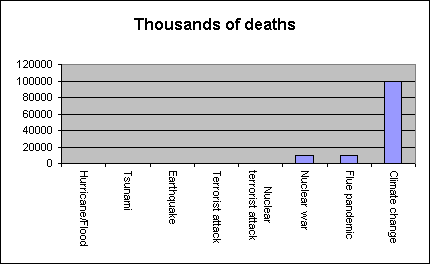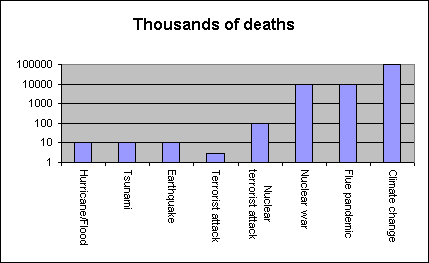
|
Home Index |
|
Home Index |
I am treating possible millions of deaths in a very unemotional way here. I apologise for that, the death or serious injury of even a single person can be devastating; but an unemotional approach needs to be used to show the facts. Our politicians are using emotion, fear of terrorist attack, to blind First World people to the true scale of the dangers that face us. They would rather look like they are doing something effective against terrorism while hiding the fact that they are doing next to nothing to avert the much larger environmental disasters that face us.
An important aspect of any disaster is the degree to which it is recoverable. This is why I believe that climate change is the greatest of all currently foreseeable and likely major disasters; much of the damage will not be recoverable except by natural processes over millions of years.
Jared Diamond listed twelve looming environmentall disasters in his book Collapse. He is right. I have not attempted to quantify 'his' disasters here (other than climate change) - it was enough work listing 'mine'.
If these estimates are anywhere near correct, why do the USA and Australian governments spend billions of dollars and tens of thousands of lives in their 'War on Terrorism' while doing very little to reduce their levels of greenhouse gas production, which are well out of proportion to their populations?
|
|
|
|
|
|
|---|---|---|---|---|
|
Hurricane/flood
Likelihood; Inevitable; becoming more frequent due to climate change | None up to hundreds of thousands depending on where it happens and its severity | Damage to houses and other buildings, mud slides, erosion, loss of fertile top soil. |
Avoidability;
Unavoidable, but First World societies can enforce building codes in hurricane
prone areas so that structures will be able to withstand most hurricanes.
Floods can be reduced by reforestation of catchments and their effects
avoided by not building in flood plains (a choice that may not be available
to Third World societies).
Recoverability; Mostly recoverable with time (a decade or so), except for the losses of soil and erosion damage etc. | |
|
|
|
|
|
|
|
Major tsunami
Likelihood; History indicates that it will happen every few decades | Thousands to several hundreds of thousand | Major damage to low-lying areas from the waves and from salt introduced to soils |
Avoidability;
Unavoidable, but many human lives could be saved by an effective early warning
system.
Recoverability; Fully recoverable with time (a decade or so) | |
|
|
|
|
|
|
|
Major earthquake
Likelihood; History indicates that it will happen every few years, with exceptionally bad earthquakes at longer intervals | Hundreds to tens of thousands | Major damage to infrastructure: buildings, roads. Little disruption to non-human species. |
Avoidability; Unavoidable
Recoverability; Fully recoverable in time | |
|
|
|
|
|
|
|
Terrorists attacks using suicide bombing
Likelihood; It is happening | Normally less than a hundred, but up to several thousands is possible (as happened with the Twin Towers). | Few. People might try to avoid the more crowded areas. |
Avoidability; If the causes inciting extremists to commit terrorist
acts can be removed then terrorist bombings might be reduced. See
Why do people hate the USA.
Recoverability; Fully recoverable | |
| Expert opinion is that so called 'dirty bombs' (conventional bombs laced with radioactive material) would cause very few deaths. | ||||
|
|
|
|
|
|
|
Terrorists obtain and use several nuclear weapons
Likelihood; Who knows? possible | Several tens of thousands up to several millions. | Will mainly depend on human behaviour - will people in other cities panic and move out to the country en-mass? Will this cause economic collapse, cultural collapse? |
Avoidability; If the causes inciting extremists to commit terrorist
acts can be removed then it might well be avoided. If nations with nuclear
weapons were to greatly reduce their armouries the ability of terrorists to
obtain bombs would be similarly reduced.
Recoverability; The city or cities attacked will retain radioactive contamination for some years; otherwise recovery could be near complete. | |
|
|
|
|
|
|
|
Strike by asteroid on major city; assuming the asteroid to be in the
(small) 100m to 1km diameter class
Likelihood; Inevitable over a long enough period, enormously unlikely in the next few years | Tens of thousands to several millions | Total devastation in the immediate area |
Recoverability; The particularly city would be entirely destroyed and the vicinity extensively damaged, but recovery would eventually be near complete. | |
|
|
|
|
|
|
|
Nuclear war; between two major nuclear powers, eg. USA and China
Likelihood; Unlikely | Tens of millions or even hundreds of millions | Blast damage would mainly be confined to areas of human occupation. Fallout and radiation would effect higher animals in much the same way as it effects humans. There is a possibility of 'nuclear winter' which could result in the extinction of many species. |
Avoidability; Entirely avoidable; nuclear weapons have been available
for sixty years and the only time they were used was by one nuclear power
against a non-nuclear power. Ie. Would any government be stupid enough to
use nuclear weapons against a nation that could retaliate?
Recoverability; Probably recoverable. There is a possibility of 'nuclear winter' which could result in the extinction of many species. | |
|
|
|
|
|
|
|
Flu pandemic; bird flu or some other variation
mutates and becomes human transmissible, virulent and highly contagious
Likelihood; Quite likely, it happens periodically; we have been lucky that it has not happened in the last three quarters of a century. | If the Hong Kong bird flu or some other virus mutates to becomes human-to-human transmissible and virulent there may be tens of millions to hundreds of millions of human deaths. | There may well be no direct effects on other species and minimal effect on infrastructure. Panic exoduses from cities might lead to environmental disruptions, overcrowding, and starvation elsewhere. |
Avoidability; There is probably nothing that can be done to avoid it.
However, its severity could be greatly reduced by various human activities.
Recoverability; Totally recoverable because it will be confined only to humans. | |
|
|
|
|
|
|
|
Climate change
Likelihood; Some is now unavoidable, but the worst effects may be avoided by concerted efforts on a world-wide scale. |
Tens of millions up to several billion.
Many low-lying river deltas such as the Mekong, Ganges/Brahma Putra and the Nile will be inundated by the rising sea levels; these areas are the most densly populated places in the world. Many fertile and highly populated areas of the First World will also go under. Global water supplies will change, rainfalls will decrease greatly in some areas and increase in other areas. Increases in the frequency of major storms will produce record floods. | Thousands of species will become extinct because of habitat loss. Major changes in global weather patterns and possibly ocean currents will occur. Runaway greenhouse effects may occur because of positive feedback effects in such things as release of greenhouse gases from melting permafrost and methane hydrides on the ocean floor. |
Avoidability; Some climate change is unavoidable, it has already
started. The worst effects could be avoided if there was the necessary
international political will.
Recoverability; The losses of species and destruction of environments would be unrecoverable. Changes in weather patterns and ocean currents may not be reversible, and even if they could be reversed the damage would already have been done. | |
|
Displacements of large populations by rising sea level and loss of
water supplies will lead to wars over territory.
History shows us that when peoples have to move from their own land they will
take land from neighbours who are weaker.
Starvation will be widespread.
Habitat destruction and deforestation due to overcrowding will lead to
even more starvation in later years.
The ocean current called the Gulf Stream makes northern Europe habitable;
it is quite probable that ocean currents including the Gulf Stream will
change if climates change substantially.
Ocean acidification is happening due to the carbon dioxide that human activity has added to the atmosphere dissolving in sea water to form carbonic acid. This is already adversely affecting the ability of small sea creatures such as foraminifera and corrals to produce their calcic skeletons. I have written at greater length on climate change from an international perspective and also from an Australian perspective elsewhere on this site. | ||||
|
Home Top Index |
Environmental disasters warned about by Jared Diamond in his book CollapseMy greatest concern is climate change. However, Jared Diamond rightly warned that there are a number of looming disasters, including climate change, that cannot be treated individually. He believes that if any eleven of the problems listed below are not fixed then the remaining one will cause at least a major disruption of our world.
|
|
Home Top Index |

|
|
|
Of course all the figures are speculative. That cannot be helped. They are reasonable guesses.
In these graphs I have used the figure of 3000 deaths from the World Trade
Centre attack of Sept. 11th 2001 as the number for a terrorist
attack as it is the greatest number killed by any (non state-sponsored)
terrorist attack. Scientific American, 'Preparing for a Pandemic', Nov. 2005
gave the number of likely deaths from a flu pandemic as "tens to hundreds of
millions'; I have used one hundred million on the graphs.
I have used the figure of one billion as the likely deaths from climate change
figuring on massive forced migrations and confrantations between nations and
societies.

|
|
|
It should be stressed that while these graphs compare disasters in terms
of human deaths another important aspect is recoverability following a
disaster. The recoverability from an environmental disaster like climate
change will be much poorer than from something like a
flu pandemic (which is confined to humans) or terrorist attack; thousands of
species and great natural structures like coral reefs will be lost.
|
Home
On this page... Asteroid strike Flu pandemic Climate change Disasters compared Earthquake Hurricane or flood Jared Diamond - environmental disasters Nuclear war Terrorist attack The numbers on graphs Top Tsunami |
|
Home Top |